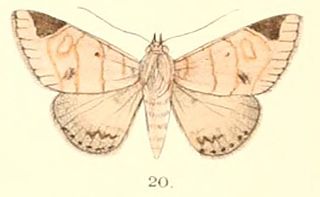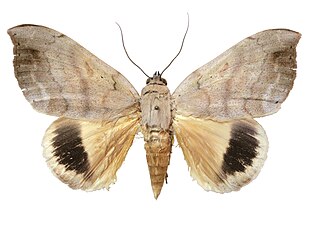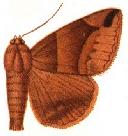
The Drepanidae are a family of moths with about 660 species described worldwide. They are generally divided in three subfamilies, which share the same type of hearing organ. Thyatirinae, previously often placed in their own family, bear a superficial resemblance to Noctuidae. Many species in the drepanid family have a distinctively hook-shaped apex to the fore wing, leading to their common name of hook-tips.

Ischyja is a genus of moths of the family Noctuidae erected by Jacob Hübner in 1823.
Dactyloplusia is a monotypic moth genus of the family Noctuidae erected by Chou Io and Lu Chinsheng in 1979. Its single species, Dactyloplusia impulsa, was first described by Francis Walker in 1865. It is found in Sri Lanka, India, southern China, Sundaland, Sulawesi, New Guinea, Fiji and Australia.

Dordura is a monotypic moth genus of the family Noctuidae erected by Frederic Moore in 1882. Its only species, Dordura aliena, was first described by Francis Walker in 1865. It is found in the Indian subregion, Sri Lanka, Myanmar, Thailand, Peninsular Malaysia, Sumatra, Borneo and New Guinea.
Plecoptera quaesita is a species of moth of the family Noctuidae. It is found in India, Sri Lanka, Burma, Andamans, Borneo, Northern Moluccas and Australia.

Ophisma pallescens is a moth of the family Noctuidae first described by Francis Walker in 1864. It is found in Thailand, Peninsular Malaysia, Sumatra, Borneo, Sulawesi, Seram and New Guinea.

Bastilla acuta is a moth of the family Noctuidae. It is found in the Himalaya, Taiwan, Peninsular Malaysia, Sumatra and Borneo.

Bastilla vitiensis is a moth of the family Noctuidae first described by Arthur Gardiner Butler in 1886. It is found from the Moluccas to Palau, Fiji, Samoa, Tonga and New Caledonia, Sulawesi, the Philippines, Borneo and Java.

Bastilla maturescens is a moth of the family Noctuidae first described by Francis Walker in 1858. It is found in the Indian subregion, Indochina, Thailand, Sumatra, Java and Borneo.
Bastilla flavipurpurea is a moth of the family Noctuidae first described by Jeremy Daniel Holloway in 1976. It is found endemic to Borneo.
Bastilla euryleuca is a moth of the family Noctuidae first described by Prout in 1919. It is endemic to Borneo.

Pindara illibata is a moth of the family Noctuidae first described by Johan Christian Fabricius in 1775. It is found in the Oriental region, including Taiwan, China, India, Sri Lanka, Myanmar, Japan and Borneo.

Trigonodes hyppasia, the triangles or semi-looper, is a moth in the family Erebidae. The species was first described by Pieter Cramer in 1779. It is largely cosmopolitan, found throughout Borneo, Fiji, India, Nepal, Sri Lanka, São Tomé and Príncipe, Taiwan, Thailand, Zimbabwe, northern Australia, and almost all African countries.
Athetis nonagrica is a moth of the family Noctuidae. It is found in Borneo, Peninsular Malaysia, Sulawesi and New Guinea.

The Erebinae are a subfamily of moths in the family Erebidae erected by William Elford Leach in 1815. Erebine moths are found on all continents except Antarctica, but reach their greatest diversity in the tropics. While the exact number of species belonging to the Erebinae is not known, the subfamily is estimated to include around 10,000 species. Some well-known Erebinae include underwing moths (Catocala) and witch moths (Thermesiini). Many of the species in the subfamily have medium to large wingspans, up to nearly 30 cm in the white witch moth, which has the widest wingspan of all Lepidoptera. Erebine caterpillars feed on a broad range of plants; many species feed on grasses and legumes, and a few are pests of castor bean, sugarcane, rice, as well as pistachios and blackberries.

Anisoneura salebrosa is a moth of the family Noctuidae first described by Achille Guenée in 1852. It is found in Taiwan, Thailand, Vietnam, Sumatra, Peninsular Malaysia, Borneo, Sulawesi, the north-eastern part of the Himalayas, Bangladesh, China, Japan and the Philippines.
The Pericymini are a tribe of moths in the family Erebidae.
The Pandesmini are a tribe of moths in the family Erebidae.
The Catephiini are a tribe of moths in the family Erebidae.

The Sypnini are a tribe of moths in the family Erebidae.









